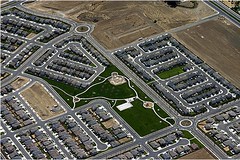The future housing market looks good for smart growth, says Business Week

Posted July 17, 2009 at 1:35PM
The June 29 issue of Business Week contains a lengthy feature (really a set of features) on what we can expect in the market for US housing between now and 2012. The short-term news for homeowners and builders is pretty bad, as no one needs to be told, if also a little better for first-time buyers. And in general the magazine predicts a mild recovery by the end of the 3-year period.
But one of the more encouraging findings within the overall report is a continued relatively strong market for smart growth. From one of the articles:
"In a rejection of suburban sprawl, homeowners may be drawn to such towns as Saratoga Springs, NY, where they can live and work. Meanwhile, far-flung exurbs like those in Kane County, IL, and the outskirts of Scottsdale, AZ, will struggle to attract new buyers . . .
"Just as the boom years bred car-centric subdivisions and strip malls, the bust may lead buyers to cities and towns centered on a commercial, retail, and residential hub . . . What makes a city livable, says urban planning and policy expert Robert E. Lang, is 'the ability to walk and not drive to go pick up the basics in your life' . . .
"When gas was cheap, the remote suburbs of Chicago, Scottsdale, and Las Vegas made more financial sense. Homes in those areas sold for a fraction of their city equivalents. And suburbanites readily drove 20 minutes to a supermarket or commuted 90 minutes to work. Then gas prices surged and the economy soured, crimping housing demand in exurbs. Even though gas prices have since fallen, those markets likely won't see boom-level prices for many years. In Kane County, Ill., empty McMansions sit beside soybeans fields. Local corn and soybean farmer Steve Pitstick says housing contractors are offering to help plant his crops and do other odd jobs."
The report's use of Saratoga Springs as an example is certainly ironic, considering their no-walking-to-school rules (now under review after all the bad publicity), but its core still is a decent example of what a mixed-use, walkable community can be. It is one of the few places surveyed in the report where home prices have remained steady over the last year.
A stark contrast among the communities featured in the report is presented by sprawling Merced, California, where property values have dropped 70 percent in some cases and roughly two-fifths of the homes are considered distressed, meaning that owners are not making their mortgage payments.  "With banks and borrowers dumping distressed homes, prices could fall by 30 percent more" in Merced, according to an analyst quoted in the report.
"With banks and borrowers dumping distressed homes, prices could fall by 30 percent more" in Merced, according to an analyst quoted in the report.
All of this is consistent with other reports over the last year (on this blog, here, here, and here). Moreover, the trend to smart-growth communities should only be strengthened by demographic forecasts, which call for a growing share of US households to be childless - and thus less enamored of a traditional suburban lifestyle - between now and 2025. This is primarily the result of a simultaneous surge in both younger singles and older empty nesters. In 1960, half of American households contained children; in 2025, the portion is forecast to be 28 percent.
While the Business Week report sees a trend in favor of walkable communities and cities, it sees a decline in the exurban and rural population, citing a UN prediction of a loss of two million residents in such places between 2010 and 2015. (I wish I had had that forecast in hand two months ago when the LEED for Neighborhood Development team was faced with passionate arguments to the effect that LEED-ND's criteria for green certification needed to be relaxed in order to be more accommodating to rural development.)
Other regions featured in the report include Omaha, where a strong job market is keeping prices stable; Seattle, which has declined but should see faster recovery than other places; Salt Lake City, where the market has slipped only slightly because of a strong supply of first-time buyers; Nashville, where immigrant purchasers have kept the decline within reasonable bounds; and Austin, one of the few places where prices have seen a recent increase.